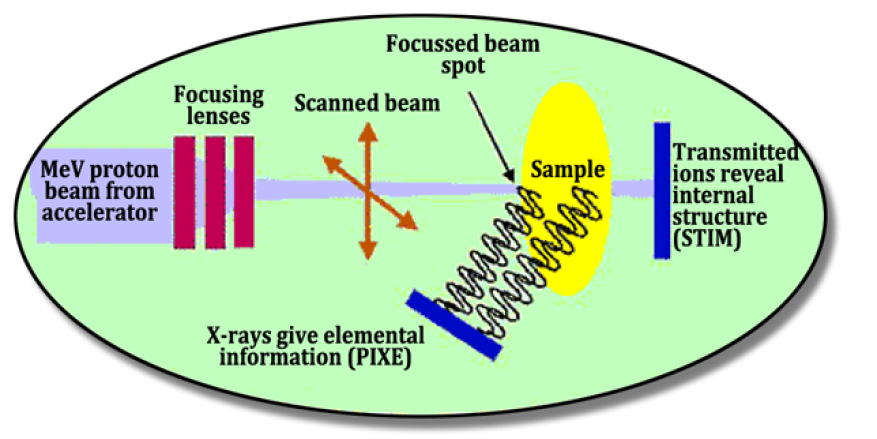HVEC 10 MV Model FN Tandem
Of the three accelerators CAMS utilizes the largest is the HVEC 10 MV Model FN Tandem, which was obtained from the University of Washington and installed at LLNL in the mid-80s.
During installation the accelerator's belt charging system was replaced with a NEC Pelletron, new Dowlish spiral-inclined beam tubes were installed, as were the gas-handling systems necessary for use of SF6 as the insulating tank gas. The FN accelerator is routinely operated at voltages up to 9.1 MV and has been operated at voltages lower than 1 MV for particular experiments.
The Low Energy end of the FN accelerator system currently incorporates four negative ion sources arranged around two injection magnets. Three of these ion sources are LLNL/CAMS Cs-sputter negative ion sources using hemispherical section ionizers and incorporating 64-sample pneumatically-driven sample changers. These Cs-sputter ion sources allow the production of a great variety of negative ion species from solid materials, literally ranging across the mass range from H– to PuO–. The fourth ion source is a NEC TORVIS negative ion source that allows the production of negative H, D, and He ions. The TORVIS source has been used predominantly for the production of up to ~10 µA beams of He– ions for use in implantation experiments. The High Energy end of the FN accelerator system currently incorporates four beam lines arranged around a large switch magnet and one beam line dedicated to AMS measurements of lighter ions.
| Isotope | Nominal Stable Ion Current |
Nominal Sample Mass |
Research Background |
Nominal Precision |
|---|---|---|---|---|
| 3H Bio | 45 µA 1H– | ~2 mg H | 4 x 10–15 | 4% |
| 14C Natural | 250 µA 12C– | 0.05–1 mg C | 50–57 ka | 0.3% |
| 14C Bio (graphite) | 120 µA 12C– | ~1mg C | 2 x 10–15 | 3% |
| 14C Bio (liquid) Moving Wire |
12 µA 12C– | 5 ug C in 5 ul solution |
1 x 10–14 | 5% |
| 10Be | 20 µA 9BeO– | 0.2 mg 9Be | 5 x 10–17 | 1-3% |
| 26Al | 1.5 µA 27Al– | ~1 mg 26Al | 2 x 10–15 | 2-5% |
| 36Cl | 35 µA 35Cl– | ~1 mg Cl | 3 x 10–15 | 1-3% |
| 41Ca | 3 µA 40CaF3– | 3-5 mg CaF3 | 1 x 10–13 | 4% |
| 129I | 30 µA 127I– | ~1 mg I | ~2 x 10–14 | 1% |
| Actinides (233,236U, 239,240Pu) |
200 nA 238U 5+(eq.) | ~ 1 mg U or ~109 atom 242Pu |
Pu: ~50 attogram U/238: 10-13 233; 10-11 236 |
2% |
| Isotope | Nominal Stable Ion Current |
Nominal Sample Mass |
Research Background |
Nominal Precision |
|---|---|---|---|---|
| 90Sr | 1uA SrF3- | ~ 1X10-13 | 3% |
Existing capabilities that are not currently being run routinely:
- 3H AMS measurements of natural samples.
- 7Be AMS measurements.
1 MV NEC Accelerator for biomedical work
For our biomedical applications our work-horse bioAMS spectrometer is currently a 1 MV accelerator mass spectrometer with a HPLC liquid sample interface (bioams.llnl.gov) . 14C and tritium analyses of biomedical samples are currently conducted using this system.
We are also currently situating a National Electrostatics Corporation 250kV accelerator mass spectrometer in a biomedical laboratory. This spectrometer represents the latest evolution in AMS technology. The replacement of the tandem accelerator component with a high voltage power deck will afford easier and less expensive operation, with a much smaller footprint over traditional AMS systems. Gas measurement capability is paramount to the success of producing real time high-density AMS data sets as the analysis of liquid samples necessary to achieve high throughput analysis requires their conversion to CO2. This system will be configured to take advantage of our liquid sample AMS instrumentation to provide directly-coupled liquid sample AMS measurement. Importantly, as this system is situated in a biological/clinical setting that will be configured as a BSL-2 laboratory it will be capable of analyzing samples that are considered Risk Group 2, such as human plasma and urine samples.
NEC 1.7 MV Model 5SDH-2 Tandem Accelerator
The NEC 1.7 MV Model 5SDH-2 Tandem Accelerator is used for Ion Beam Analysis. With this system, up to 50-keV H- ions produced by an off-axis duoplasmatron ion source are accelerated and stripped of electrons in a 1.7 MV NEC 5SDH-2 tandem electrostatic accelerator to produce microampere currents of MeV energy H+ ions (protons). The central portion of this beam can be collimated before being focused onto the specimen by magnetic quadrupole lenses (Figure 1) to produce, MeV energy µm sized proton beams with nA beam currents. Although there are a variety of irradiation products that can be monitored, we primarily use three analytical techniques: Proton Induced X-ray Emission (PIXE), Backscattering spectroscopy and Scanning Transmission Ion Microscopy (STIM). With these techniques focused beams can be scanned over a sample to produce maps of element distribution (Figure 2).
The 5SDH-2 Tandem Accelerator system is also used to produce neutron beams by irradiating lithium and other materials with microampere proton beams of selected energies. The neutrons are used for a variety of purposes including testing and calibration of new neutron detectors.






